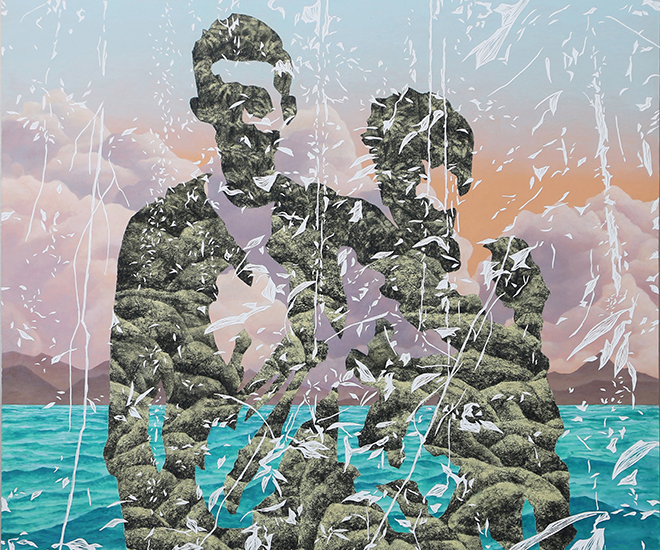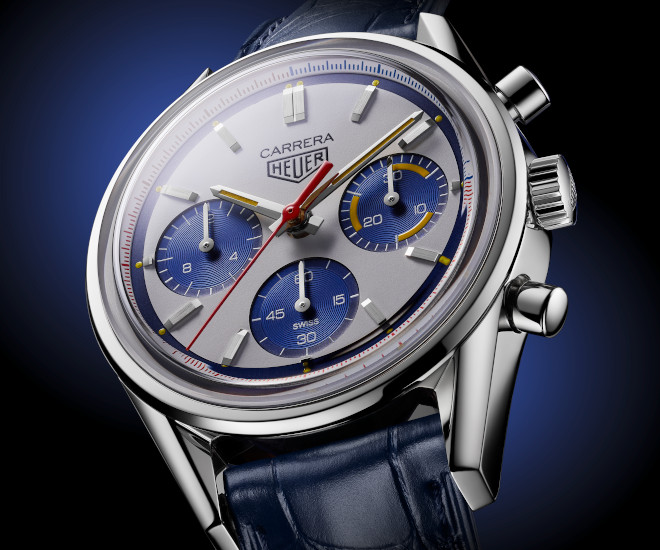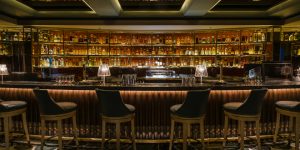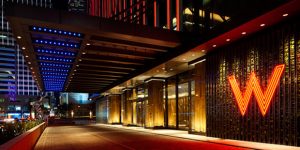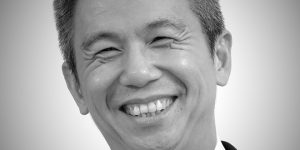How Trash TV and Hong Kong Design Sense Inspired Mojoko’s Iconic Career
Born in Iran, raised in Hong Kong and educated in Europe, Mojoko is best known for diversified career in curation, installation, interactive design and fine art.

Steve Lawler, better known as Mojoko, was born in Iran, raised in Hong Kong and educated in Europe – where he attended the prestigious FABRICA art residency in Treviso, Northern Italy in 2001, before kickstarting his interactive design career at Diesel HQ.
Catapulting through the industry as an Artist, Designer, Art Director and Creative Director, Mojoko established the Kult Magazine, Gallery and Studio, quickly building a reputation for his diversified career in curation, installation, interactive design and fine art.
Having worked with a global network of over 600 phenomenal artists, designers and animators, Mojoko is now the Creative director of The Unusual Network, an international collection of creators, where he is responsible for the quarterly publication of EYEYAH! – an illustrated guide to the world for kids (and kidults).
How Trash TV and Hong Kong Design Sense Inspired Mojoko’s Iconic Career
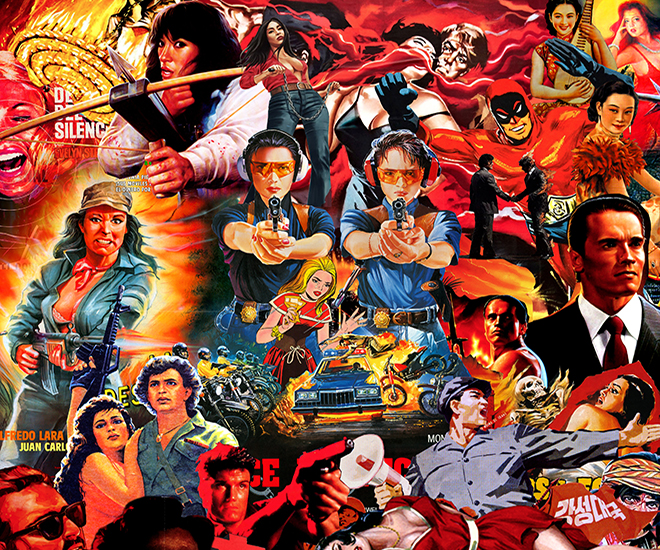
You are British, born in Iran and you spent your youth in Hong Kong. Quite a start in life! It seems that Hong Kong has always had a lasting influence on your art, why is the city your muse?
Hong Kong was an overload on the senses, the neon lights, the volume of people, the sights and smells were intense. The energy is infectious and the juxtaposition of Western and Asian culture was everywhere, Chinese movies with English subtitles, Rambo movie posters with Chinese typography. I found it fascinating and still do. There is definitely an air of nostalgia about it for me, but it was so futuristic and still does feel like one of the most exciting cities in the world.

Your art is strongly inspired by B-movies, trash TV, and alternative culture. When did it all begin?
I think it was born by rejection of the mainstream. I always hated pop music and big Hollywood films. I found alternative music and culture much more exciting and unusual. For example in a VHS video rental store, I was much more glamoured by the graphics and titles of the weird sections than the blockbuster films. They were much more intriguing and explicit.
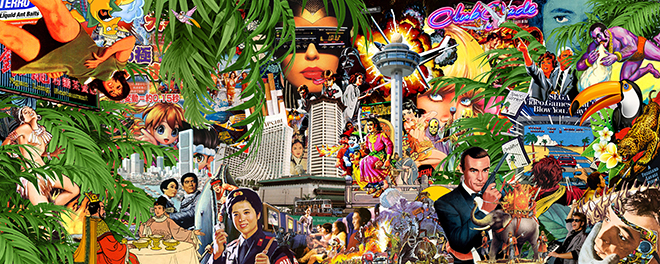
Which is your favourite medium to work with? Has collage always been at the very core of your creative process?
Everything I do has an element of collage, it’s the interplay between two separate ideas which create a spark. The creative process is very much started by linking two previously unlinked ideas. This idea multiplies with more and more elements, so the trick is to try and control or guide it so that your concept or theme is understood.

Tell us more about the incredible collection of comic books, 80s advertisements, B-grade movie posters you have amassed over the years. When did you start to collect these? Are these still easy to find or are you now more looking for references and inspiration online?
I must have started collecting around late 90’s. Everything from Rave flyers, typography, vintage catalogues and that just became a habit to seek out the obscure things in flea markets and jumble sales. I used to make scrapbooks and then anything that was not cut up was put into a kind of filing system. I still keep on searching for new (old) things, that’s what keeps me going and triggers inspiration. And yes online has become a valuable resource for finding things, but in Asia there is very little 60s,70’s pop culture documented online, you have to dig for that the old fashioned way.
You love large scale installations as well as unconventional places. You have worked in Singapore, Tokyo, Taipei … Are there any other capital cities you would love to work and exhibit in?
I would be happy to have more shows in Europe. Paris, London, Amsterdam for example. I have sold works there and have some great buyers there, but never had the opportunity to showcase there. I look forward to that.

Mojoko sounds funky and rather universal …. It could come from Japan, Indonesia or Nigeria. When did you adopt this artist name and where did it come from?
Actually the name comes from the Printing process CMYK. I was playing with colour values on my computer and I noticed M=0 Y=0 K=0. It just resonated with me, and yes it felt like it could be African or Japanese or Indonesian. So I loved that versatility of the moniker.

Do you still feel British living in Asia for so long?
I think I have a British sense of humour, but am not particularly patriotic about the UK. I still look to it as a benchmark for creativity and quality content, but I do enjoy a global perspective on all things art, music, film.
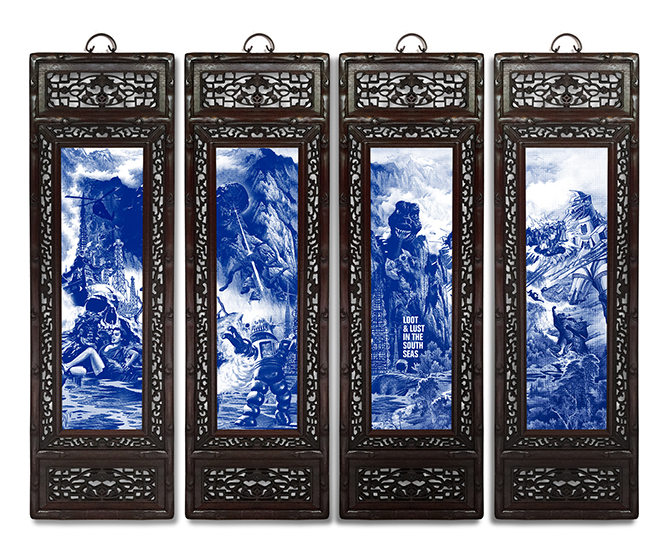
Where can we see some of your work online, are these for sale?
The most up to date place to see what am up to is Instagram and if you are looking for archive projects and prints, please visit my website.

You have been in Singapore for over 13 years. What are your thoughts on Singapore’s art and design scene? What would you like to see more of? Any art event you would like to see coming to the island-city?
I think the biggest problem is, and will continue to be, that artists can’t afford spaces to create and show work, the scene is primarily gallery driven, which means non-commercial work has very little opportunity to grow its influence. Artist run spaces are always where you see the most progressive work, and we (the community) should recognise and try to nurture that.

Are there other countries in SEA which attract you to their artistic vibe and scene: Vietnam, Indonesia, the Philippines, Myanmar?
I have always loved the visual power of work from the Philippines and Indonesia. They would be my favourite Southeast Asian countries closely followed by Thailand. I would have to say its Korean art which has excited me the most over the years. Always pushing forward, a real thrust for originality seems to be a driver there In terms of medium and subject matter. Their harnessing of kinetic sculpture and craft is most impressive.

You are a favourite amongst many art collectors across SEA. Are some of your artworks already displayed in Museums?
I have had a number of works featured in Museums but most of them were temporary. The Singapore Art Museum has been the biggest Patron, commissioning a mix of digital installations and sculptures over the years. I have some Museum projects in the pipeline but they are still under wraps for now.
Tell us about your current show in Singapore, “The Secret Room”. What can we expect to see?
‘THE SECRET ROOM’ delves into mystery and intrigue of the past but with a modern twist: deconstructed antiques, traditional paintings and objects infused with contemporary internet culture. The installation features over 20 new artworks in varying traditional mediums, such as rosewood furniture, lanterns, ceramics and glass but with a modern twist.

If you were to name one mentor who has inspired you in your path as an artist, who would that be?
During my second year at University we had a film module which was led by Dr.Chris Mullen. He introduced me to the visual telling of stories and world of alternative cinema. He was the most knowledgeable person across so many subjects. He has one of the largest comprehensive archives of imagery online here: http://www.fulltable.com/VTS/index2.htm
–
For more on the artist:
